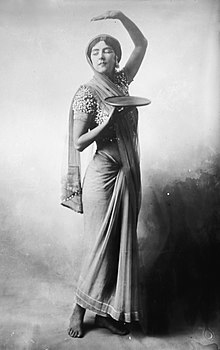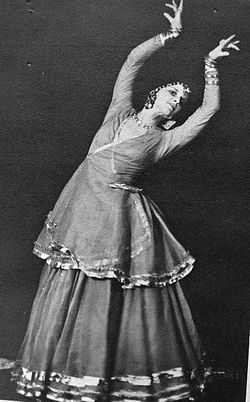Ruth Saint Denis (January 20, 1879 â€" July 21, 1968) was a modern dance pioneer, introducing eastern ideas into the art. She was the co-founder of the American Denishawn School of Dance and the teacher of several notable performers.
Biography

Ruth Denis was raised on a small farm in New Jersey, daughter of Ruth Emma Denis ( a physician by training), where she studied both Christian Science and theosophy. As a child, she learned exercises based on François Delsarte's Society Gymnastics and Voice Culture. This was the beginning of St. Denis's dance training, and was instrumental in developing her technique later in life. In 1894, after years of practicing Delsarte poses, she debuted as a skirt dancer for Worth's Family Theater and Museum. From this modest start, she progressed to touring with an acclaimed producer and director, David Belasco, under whom her stage name, "St. Denis", was created. While touring in Belasco's production of Madame DuBarry in 1904 her life was changed. She was at a drugstore with another member of Belasco's company in Buffalo, New York, when she saw a poster advertising Egyptian Deities cigarettes. The poster portrayed the Egyptian goddess Isis enthroned in a temple; this image captivated St. Denis on the spot and inspired her to create dances that expressed the mysticism that the goddess's image conveyed. From then on, St. Denis was immersed in Oriental philosophies.
In 1905, St. Denis left Belasco's company to begin her career as a solo artist. The first piece that resulted from her interest in the Orient was Radha performed in 1906. Drawing from Hindu mythology, Radha is the story of Krishna and his love for a mortal maid.Radha was originally performed to music from Léo Delibes' opera Lakmé. This piece was a celebration of the five senses and appealed to a contemporary fascination with the Orient. Although her choreography was not culturally accurate or authentic, it was expressive of the themes that St. Denis perceived in Oriental culture and highly entertaining to contemporary audiences. St. Denis believed dance to be a spiritual expression, and her choreography reflected this idea.
In 1911, a young dancer named Ted Shawn saw St. Denis perform in Denver; it was artistic love at first sight. In 1914, Shawn applied to be her student, and soon became her artistic partner and husband. Together they founded Denishawn, the "cradle of American modern dance." One of her more famous pupils was Martha Graham. Together St. Denis and Shaw founded the Los Angeles Denishawn school in 1915. Students studied ballet movements without shoes, ethnic and folk dances, Dalcroze eurhythmics, and Delsarte gymnastics. In 1916 they created a collection of dances inspired by Egypt which included Tillers of the Soil a duet between St. Denis and Shawn as well as Pyrrhic Dance an all male dance piece. Her exploration into the orient continued into 1923 when she staged Ishtar of the Seven Gates in which she portrayed a Babylonian goddess. Together St. Denis and Shawn toured throughout the 1910s and 1920s often performing their works on the vaudeville stage.
Other notable dancers such as Doris Humphrey, Lillian Powell, Evan-Burrows Fontaine and Charles Weidman also studied at Denishawn. Graham, Humphrey, Weidman and the future silent film star Louise Brooks all performed as dancers with the Denishawn company. At Denishawn, St. Denis served as inspiration to her young students, while Shawn taught the technique classes. Ruth St. Denis and Ted Shawn were also instrumental in creating the legendary dance festival, Jacob's Pillow.
Although Denishawn had crumbled by 1930, St. Denis continued to dance, teach and choreograph independently as well as in collaboration with other artists. St. Denis no longer redirected her works from the mysteries of the orient to combining religion and dance through her Rhythmic Choir of Dancers. Through these works it is said that St. Denis sought to become the Virgin Mary in the same manner in which she once sought to become goddesses. In 1938 St. Denis founded Adelphi University's dance program, one of the first dance departments in an American university. It has since become a cornerstone of Adelphi's Department of Performing Arts. She cofounded a second school in 1940, the School of Nataya which focused on teaching Oriental dance. For many years St. Denis taught dance at a studio in Hollywood, near the Hollywood Bowl. In 1963 she teamed with Raymond D. Bowman to bring the first full-length Balinese Shadow Puppet play to the United States. The performance was held at her studio and lasted more than eight hours. St Denis passion for religious understanding through the arts was further extended when she founded the St. Denis Art Church located in California.
Ruth Saint Denis died of a heart attack in 1968, aged 89, at Hollywood Presbyterian Hospital in Los Angeles.
Legacy

The legacy left behind included not only her repertory of orient-inspired dances, but also students of Denishawn who later became pivotal figures in the world of modern dance. Many companies currently include a collection of her signature solos in their repertoires, including the programme, "The Art of the Solo", a showcase of famous solos of modern dance pioneers. Several early St. Denis solos (including "Incense" and "The Legend of the Peacock") were presented on September 29, 2006, at the Baltimore Museum of Art. A centennial salute was scheduled with the revival premiere of St. Denis' "Radha", commissioned by Countess Anastasia Thamakis of Greece. The program's director, Mino Nicolas, has been instrumental in the revival of these key solos. St. Denis was inducted into the National Museum of Dance's Mr. & Mrs. Cornelius Vanderbilt Whitney Hall of Fame in 1987. The global organization and activity, the Dances of Universal Peace, credits Ruth St. Denis for much of the inspiration behind its creation. The Dances of Universal Peace organization subsequently published many of St Denis' previously unpublished writings on spiritual dance and the mysticism of the body.
See also

- Sada Yacco
- Ted Shawn
- Isadora Duncan
- Modern dance
- Women in dance
- Rue Saint-Denis (Paris) (homonym)
- Edna Guy
References

Further reading

- Miller, Kamae A. Wisdom Comes Dancing: Selected Writings of Ruth St. Denis on Dance, Spirituality and the Body. Seattle: PeaceWorks. 1997. ISBN 0-915424-14-2
- Shelton, Suzanne. Divine Dancer: A Biography of Ruth St. Denis. New York: Doubleday, 1981.
- Ted Shawn, Ruth St. Denis: pioneer & prophet; being a history of her cycle of oriental dances. Printed for J. Howell by J. H. Nash, 1920.
- St. Denis, Ruth. An Unfinished Life: an Autobiography. Dance Horizons Republication, Brooklyn, New York, 1969.
- Terry, Walter. Miss Ruth: the "more living life" of Ruth St. Denis. Dodd, Mead, New York, 1969.
- Schlundt, Christena L. Into the mystic with Miss Ruth. Dance Perspectives Foundation, 1971.
- Vito Di Bernardi, Ruth St. Denis. Palermo, L'Epos, 2006. ISBN 88-8302-314-5
External links
- Society Gymnastics and Voice Culture.
- Guide to the Clarence McGehee Collection on Ruth St. Denis. Special Collections and Archives, The UC Irvine Libraries, Irvine, California.
- Guide to the Photograph Collection on Ruth St. Denis. Special Collections and Archives, The UC Irvine Libraries, Irvine, California.
- Archive footage of Ruth St. Denis performing in Liebestraum in 1949 at Jacob's Pillow.
- Chapter 2: The Solo Dancers: Ruth St. Denis (1879-1968) from "The Early Moderns Web Tutorial" at the University of Pittsburgh
- Archive footage of Ruth St. Denis performing "The Delirium of the Senses" from Radha in 1941 at Jacob's Pillow
- Ruth St. Denis portrait gallery at Corbis
- Images from the St. Denis (Ruth) Papers. Library Special Collections, UCLA Library
